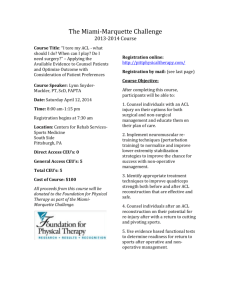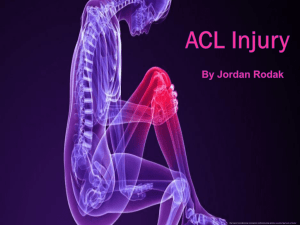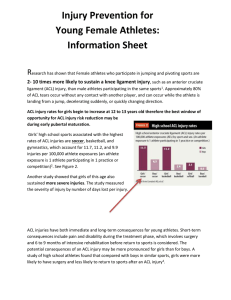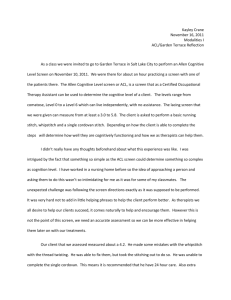ACL Lecture 26-10-10 - Elite Physical Medicine
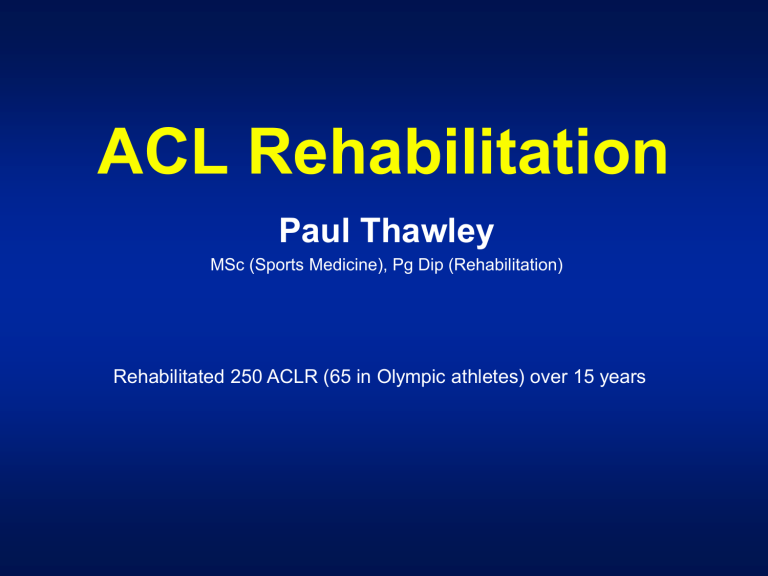
ACL Rehabilitation
Paul Thawley
MSc (Sports Medicine), Pg Dip (Rehabilitation)
Rehabilitated 250 ACLR (65 in Olympic athletes) over 15 years
Introduction
This Lecture will cover the following:
A very Brief overview of possible Biomechanics of
ACL injury
Intrinsic and extrinsic Factors
Recent evidence on changing Intrinsic factors
Prerequisites to good Clinical Rehabilitation
The Phases of Rehabilitation and examples, How to progress from phase to phase
The importance of Proprioception
Return to Sport Strategies
Possible Injury prevention
Learning Objectives
Understand Possible mechanisms for injury and the need to address these factors within Rehabilitation.
Understand the roles of rehabilitation and its phases.
Have the ability to create a simple ACLR program.
Have an a grasp on current research concepts relating to ACLR and current rehabilitation strategies
ACL Injury
What does the ACL do?
Stabilising role
Screw home mechanism
Factors Relating to ACL Injury
Intrinsic Factors
Extrinsic factors
These are difficult to change
These can be addressed with good rehabilitation /
S&C
Contributing Injury Factors To ACL Injury
Factors are Multiple and varied; difficult to measure due to effect of these variables on individual Biomechanics and Movement Patterns.
However we need to create a framework based on current evidence and best practice, to do this we need to understand possible causes.
Possible contributing factors to injury
Knee Position
Timing / Phase in athletic movement
Central Fatigue
Trunk Instability / Movement
Poor Movement Pattern / Motor control
Inadequate sports specific training / S&C
Knee Position
Knee Close to Extension, Valgus Collapse / Knee Abduction frequent.
Hewett et al 2005
Fast increase in valgus angle 3 or 4 ° 15 or 16 ° in ms
Krosshaug et al 2007.
Minimal Internal / External Rotation
Olsen,Mykelbust et al (2004)
Lateral trunk movement
Hewett Torg and Boden (2009)
Quatman and Hewitt (2009)
Quadraceps firing hard (Anticipating?)
Boden et al (2000)
Timing / Phase in Athletic movement
Deceleration
Change in direction. Besier et al (2003),
Landing Strategies
Plant & cut situations. De Morat (2004)
Fixed Foot Position
Multi Plane Mechanism with Trunk over compensation.
Shifted Centre of Mass. Quatman et al (2010)
More Recently evidence exists to link the following
Intrinsic variables to ACL injury
Central fatigue
Borotikar et al (2008), Hewett et al (2005), Mclean and Samorezov (2009),
Van Hecke (2009) ? Many Factors Kapreli (2009) Plasticity, Becomes a
Neurophysiological Impairment
Trunk instability
Lateral Angulation ? = Altered Knee Abduction Torque
Zazulak et al (2005), Zazulak et al (2007)
Poor movement patterns
Linked to variables above, but may also poor technique / previous Injury ?????????????????
(Chappell, and Limpisvasti (2008), Hewett et al (2002)
Inadequate sports specific training / S&C
McLean (2008), Shaw et al (2005)
“Dynamic stability of an athlete’s knee depends on accurate sensory input and appropriate motor responses to meet the demands of rapid changes in trunk position during cutting, stopping, and landing movements ”
Hewitt et al (2002), Hewitt et al (2005)
Are these Athletes weak?
“Inadequate neuromuscular control of the body’s trunk or “core” may compromise dynamic stability of the lower extremity and result in increased abduction torque at the knee, which may increase strain on the knee ligaments and lead to injury ”.
Zazulak et al (2005)
Weak Glutei muscles create pelvic shear and alter kinetics. Hewitt et al (2005)
Outcome depends on good Rehabilitation
The ACL Guidelines which will be on MOODLE are a combination of current Research and Rehabilitating over
200 ACL reconstructions, (60 in Olympic Athletes)
1. Clinically reasoned approach.
2. Understand the Mechanism of injury
3. Good Biomechanical assessment
4. Prioritise & Address problems identified
5. Tissue Healing knowledge vital
6. Progression Based on Physical and Clinical reassessment
7. Have a long term Injury prevention / protection strategy in place.
The Phases Of Rehabilitation with Goals
Keep it Simple and Measureable !
Pre op
Early Phase
Middle Phase
Late Phase
Return To Play Strategy
PRE OP
Very important
Phase 0 : Pre-operative Recommendations
Following diagnosis, specialist consultation and a surgery date is set.
(Normally a minimum of 6 weeks from injury to reconstructive surgery)
Pre - operatively the athlete requires the following
•Normal gait
•AROM 0 to 120 degrees of flexion
•Strength: 20 x SLR with no lag
•Minimal effusion
•Athlete education on the post-operative rehabilitation process, a fixed appointment for Physiotherapy no later than 10 days post op.
•A MDT discussion / meeting pre op to discuss and plan early phase rehabilitation,
Aims of Rehabilitationearly stage
• Manage Pain
• Manage inflammation
• Protection Joint / injured tissue / healing
• Joint Range of movement
• Normalise movement / gait
• Muscle Control/ Recruitment
• Proprioception
Why is immediate AROM is Vital?
1. To prevent Arthrofibrosis: Which may lead to painful permanent loss of range of motion. Perry et al (2005
2. Loss of knee extension and hyperextension which has shown poor
Quadriceps recruitment patterns. Also prevents scar between intercondylar notch and graft. Shelbourne et al (2006)
3. Loss of knee flexion, related to Patella femoral joint pain. Shaw (2005)
Early recovery of full active and passive range of motion has been proven to prevention of Arthrofibrosis.
Shelbourne et al (1998)
Avoid Loaded uncontrolled OKC exercise
ACL Rehabilitation Guidelines (9 months protocol)
PHASE 1 :
Immediate Post-operative Phase (Surgery to 2 weeks)
GOALS:
Full knee extension ROM (very important)
Good quadriceps control (≥ 20 no lag SLR)
Minimize pain
Minimize swelling
Normal gait pattern
PHASE 2:
Early Rehabilitation Phase (Approximate timeframe: weeks 2 to 6)
GOALS:
Full ROM
No quadriceps / hamstring inhibition
Progress neuromuscular retraining
Improve proprioception
Knee Extension And Gluteal Activation
Early Hamstring activation, very important?
Work Mid Range Initially then Extend range to Inner and Outer ranges.
Aims of Rehabilitation middle stage
• Address Biomechanics
• Muscle flexibility
• Neurodynamics
• Muscle Strength
• Proprioception
• CV fitness
PHASE 3: Strengthening & Control Phase
(Approximate timeframe: weeks 7 through 12)
GOALS:
Maintain full ROM
Running without pain or swelling
Hopping without pain, swelling or giving-way
Increased inner range hamstring control and power
PHASE 4: Training Phase (Approximate timeframe: weeks 13 to 17)
GOALS:
Running patterns (Figure-8, pivot drills, etc.) at 75% speed without difficulty
Jumping without difficulty
Hop tests at 75% contralateral values
Cybex H:Q ratio / Peak torque / Endurance
(work completed within 25% of normal contra lateral side)
Start Sports specific pattern work.
Middle Phase ACL Rehabilitation
Video
Late Phase ACL Rehabilitation
Aims of Rehabilitation late stage
• Muscle strength / Endurance
• Speed and power
• Impact tolerance / Tissue hardening
• Direction change / Pivoting/ Agility
• Coordination
• Sports Specific work
• Future Joint protection and prevention of re injury
PHASE 5: Adaptive Phase (Approximate timeframe: weeks 18 to 26
)
Goals
•85% contralateral strength 10RM
•Cybex Q:H ratio, Peak torque / endurance within 10% of uninjured leg
•85% contralateral on hop tests
•Start controlled Randori without pain, swelling, or difficulty
PHASE 6: Advanced / Final Phase (Approximate timeframe: weeks 26 to 38)
Goals
Technical ++++
Sports Specific
Complex Rotation Multi Segmental Tasks
Unconstrained Ballistic / Plyometeric Tasks
Training Principles-
Progressive Overload
This comes in the Rehabilitation Module, so you will feel Comfortable working and progressing with S&C.
Simple what are the variables at end stage
Rehabilitation that can be manipulated to progress?
Sports Specificity
Know Your Sport!
“Are there other criteria whereby we should measure treatment outcome other than the time to return to sport?
” Myklebust and Bahr (2005)
Return to sport criteria for my Athletes Is
Closely linked to Assessing Lower limb function Regularly on Elite and Podium
Athletes
RETURN TO SPORT CRITERIA
•
Final assessment from knee specialist
•
No functional complaints
•
High level of Judo specific techniques and movements under rotational loading
•
Normal isoskinetic knee assessment
• Confidence when jumping at full speed
• 90% contralateral values on hop tests Hop tests (single-leg hop, triple hop, crossover hop, 6 meter timed-hop)
• 90% contralateral values Vertical jump
• 90% contralateral values Deceleration shuttle test
? Injury Prevention
Lower Limb Control
Proprioception / Movement
Pattern Acquisition
Mechanoreceptors in ligaments / joint capsules
– Afferent nerves
–
Tendon organs
–
Muscle spindle
Combined , these afferents help to give brain a position sense motor neuron pool for quadriceps and hamstrings
Stimulation of ACL gives decrease AP laxity. Iwasa and Kawasaki et al (2006)
? Ligaments like ACL may have SENSORY role.
Brain Plasticity and Movement pattern generators. Kapreli et al (2009)
Proprioception / Movement
Pattern Acquisition
? After Injury altered joint position sense
? Before ACL Injury, Previous Pelvic / LBP
Change to motor control
Altered latency onset of muscle contraction,
Inadequate sequencing / Patterning
ACL Injury Pack
ACL Prevention Program: ( PEP Program: Prevent injury and Enhance Performance )
ACL Rehabilitation linked to tissue healing and Physiology
ACL Rehabilitation Clinical Guidelines (9 months protocol)
What We Know
The ACL is loaded by a variety of combined sagittal and non sagittal mechanisms during dynamic sport postures considered to be high risk.
1 –, 6
In vivo strain of the ACL is related to maximal load and timing of ground reaction forces.
7 , 8
Females typically display a more erect (upright) posture when contacting the ground during the early stages of deceleration tasks.
9
–,
12
Maturation influences biomechanical and neuromuscular factors.
13 –, 20
Fatigue alters lower limb biomechanical and neuromuscular factors suggested to increase ACL injury risk.
2 , 21
–,
23
The effect of fatigue is most pronounced when combined with unanticipated landings, causing substantial central processing and central control compromise.
24
Trunk and upper body mechanics influence lower extremity biomechanical and neuromuscular factors.
12 , 25 , 26
Hip position and stiffness influence lower extremity biomechanical factors.
2 , 10 , 27
We Don't Know
We still do not know the biomechanical and neuromuscular profiles that cause noncontact ACL rupture.
An understanding of the causes is central to identifying how to pre screen
We do not yet understand the role of neuromuscular and biomechanical variability in the risk of indirect or noncontact ACL injury.
Are there optimal levels of variability, and do deviations from these optimal levels increase the risk of injury?
Is noncontact ACL injury an unpreventable accident stemming from some form of cognitive dissociation that drives central factors and the resulting neuromuscular and biomechanical patterns?
Is gross failure of the ACL caused by a single episode or multiple episodes?
Is noncontact ACL injury governed by single or potentially multiple high-risk biomechanical and neuromuscular profiles?
1.
Markolf K.L, Burchfield D.M, Shapiro M.M, Shepard M.F, Finerman G.A, Slauterbeck J.L. Combined knee loading states that generate high anterior cruciate ligament forces. J Orthop Res. 1995;13((6)):930 –935. [PubMed]
2.
McLean S.G, Huang X, Su A, Van Den Bogert A.J. Sagittal plane biomechanics cannot injure the ACL during sidestep cutting. Clin
Biomech (Bristol, Avon) 2004;19((8)):828 –838.
3.
Shimokochi Y, Shultz S.J. Mechanisms of noncontact anterior cruciate ligament injury. J Athl Train. 2008;43((3)):396 –408. [ PMC free article ] [PubMed]
4.
Withrow T.J, Huston L.J, Wojtys E.M, Ashton-Miller J.A. The effect of an impulsive knee valgus moment on in vitro relative ACL strain during a simulated jump landing. Clin Biomech (Bristol, Avon) 2006;21((9)):977
–983.
5.
Yu B, Garrett W.E. Mechanisms of non-contact ACL injuries. Br J Sports Med. 2007;41((suppl 1)):i47 –i51. Aug. [ PMC free article ]
[PubMed]
6.
Shin C.S, Chaudhari A.M, Andriacchi T.P. The influence of deceleration forces on ACL strain during single-leg landing: a simulation study. J Biomech. 2007;40((5)):1145 –1152. [PubMed]
7.
Cerulli G, Benoit D.L, Lamontagne M, Caraffa A, Liti A. In vivo anterior cruciate ligament strain behaviour during a rapid deceleration movement: case report. Knee Surg Sports Traumatol Arthrosc. 2003;11((5)):307 –311. [PubMed]
8.
Withrow T.J, Huston L.J, Wojtys E.M, Ashton-Miller J.A. The relationship between quadriceps muscle force, knee flexion, and anterior cruciate ligament strain in an in vitro simulated jump landing. Am J Sports Med. 2006;34((2)):269
–274. [PubMed]
9.
Schmitz R.J, Kulas A.S, Perrin D.H, Riemann B.L, Shultz S.J. Sex differences in lower extremity biomechanics during single leg landings. Clin Biomech (Bristol, Avon) 2007;22((6)):681 –688.
10.
Pollard C.D, Sigward S.M, Powers C.M. Gender differences in hip joint kinematics and kinetics during side-step cutting maneuver. Clin J Sport Med. 2007;17((1)):38 –42. [PubMed]
11.
Decker M.J, Torry M.R, Wyland D.J, Sterett W.I, Steadman R.J. Gender differences in lower extremity kinematics, kinetics and energy absorption during landing. Clin Biomech (Bristol, Avon) 2003;18((7)):662 –669.
12.
Houck J.R, Duncan A, De Haven K.E. Comparison of frontal plane trunk kinematics and hip and knee moments during anticipated and unanticipated walking and side step cutting tasks. Gait Posture. 2006;24((3)):314
–322. [PubMed]
13.
Barber-Westin S.D, Galloway M, Noyes F.R, Corbett G, Walsh C. Assessment of lower limb neuromuscular control in prepubescent athletes. Am J Sports Med. 2005;33((12)):1853
–1860. [PubMed]
14.
Barber-Westin S.D, Noyes F.R, Galloway M. Jump-land characteristics and muscle strength development in young athletes: a gender comparison of 1140 athletes 9 to 17 years of age. Am J Sports Med. 2006;34((3)):375 –384. [PubMed]
15.
Hewett T.E, Myer G.D, Ford K.R. Decrease in neuromuscular control about the knee with maturation in female athletes. J Bone
Joint Surg Am. 2004;86((8)):1601 –1608. [PubMed]
16.
Noyes F.R, Barber-Westin S.D, Fleckenstein C, Walsh C, West J. The drop-jump screening test: difference in lower limb control by gender and effect of neuromuscular training in female athletes. Am J Sports Med. 2005;33((2)):197 –207. [PubMed]
17.
Quatman C.E, Ford K.R, Myer G.D, Hewett T.E. Maturation leads to gender differences in landing force and vertical jump performance: a longitudinal study. Am J Sports Med. 2006;34((5)):806
–813. [PubMed]
